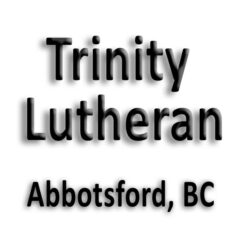A Lutheran Church worship service is currently and historically liturgical. Below is an excellent article by Rev. David Haberstoke that describes the rationale for why liturgy is important.
WHY LITURGY?
by Rev. David Haberstoke
Lutheran Church–Canada (LCC)’s Central Regional Pastor
This article was originally printed in the
September/October 2023 issue of The Canadian Lutheran
and is reprinted with permission
Why do Lutherans do liturgy? To answer the question, we first have to define what we mean by the word “liturgy.” It’s usually used by Lutherans in two ways: first, to mean the way in which Lutherans worship (with an orderly set of words for both pastor and parishioners rooted in Scripture). Secondly, it’s used to refer to the specific services in our hymnals.
Many pastors refer to the Divine Services in our hymnals as the “Historic Liturgy” of the Church. This distinguishes them from the tendency in recent decades to vary the text of the service from week to week (for example, in what Concordia Publishing House calls “Creative Worship”). Creative Worship is certainly liturgical in the first sense above because it is an orderly outline with responses. But when I ask why Lutherans “do liturgy,” I mean the second sense: the Historic Liturgy”—that is, the liturgies in our hymnals which Lutheran Church–Canada congregations in convention have accepted, recommended, and agreed to use. Why do we do these historic liturgies? There are many reasons but here are just a few:
- Because they are solid and unchanging in a world which is constantly changing.
Scholars, of course, would point out that the liturgy has changed over time. But generally, this change has been gradual, with changes and additions made bit by bit over the centuries. Divine Service Settings 1 and 2 in the Lutheran Service Book represented a departure from this slow and gradual
process when they were introduced nearly fifty years ago, because they introduced a lot of change all at once. But even they follow the general outline of the older Setting 3. Once learned, Settings 1 and 2 also become a solid and stable thing you can hold onto in an ever-changing world. - It is Scriptural.
Almost all of the words in the liturgy are straight out of the Bible or are a summary of things in the Bible. I remember being shocked in my teen years reading 1 John and realizing that those words we say in Setting 1—“If we say we have no sin…”—were straight out the Bible. - Repetition is the key to learning.
You learn, grow to understand, and remember the things you repeat regularly. Repeating things together until they are learned by heart is the best way to serve the aged, the very young, and the parent with a crying child in service. It keeps us all together supporting each other as no other technology can. - It is orderly.
St. Paul says of worship that things need to be done in good order, “for God is not a God of confusion, but of peace” (1 Corinthians 14:33). Order is something that young people raised in our present world of endless variety are drawn to and are actively seeking. Order gives them an anchor, a stable thing to connect to and root their lives in (Hebrews 6:19). - It teaches the most important things you need to know.
The core teachings and practices of the Christian faith are included in the liturgy. From the very first Easter Sunday, Christians have always gathered for God’s Word, prayer, and the Lord’s Supper (e.g., John 20; Acts 2:42; 20:7). From there, the liturgy developed by adding the most important things we need to know. For example, when the creeds were written to clarify who our Triune God is and what He does, they were then added to the weekly liturgy so that we would learn them by heart. - It connects us to the whole church throughout the ages.
When we use the liturgy handed down to us, we are being truly democratic and inclusive in that we are allowing the whole Church throughout the ages to have a say in how we do things! Not that it’s about voting; it’s about the teaching of Scripture and how all the saints of all the ages have handed this blessed faith on to us. We worship in the same patterns and traditions they used and passed on. We sing the very songs of the saints who have gone before and of heaven itself. Most canticles we sing in the liturgy are songs of the angels (the Gloria and Sanctus) or of the saints in Scripture (Kyrie, Agnus Dei, Magnificat, Nunc Dimittis, Benedictus, and so on.) - It is evangelistic.
“Evangelistic” simply means Gospel, and the Gospel is the power of God unto salvation (Romans 1:16)! When a pastor fails to preach the Gospel with clarity, the liturgy does. I have heard sermons that were all Law and no Gospel, and left us in dread of our sins. But then the Offertory (“Create in Me” – Psalm 51) immediately followed, applying the balm of God’s forgiveness to our hurting hearts, pointing us to Jesus. Pointing sinners to Jesus is true evangelism!
